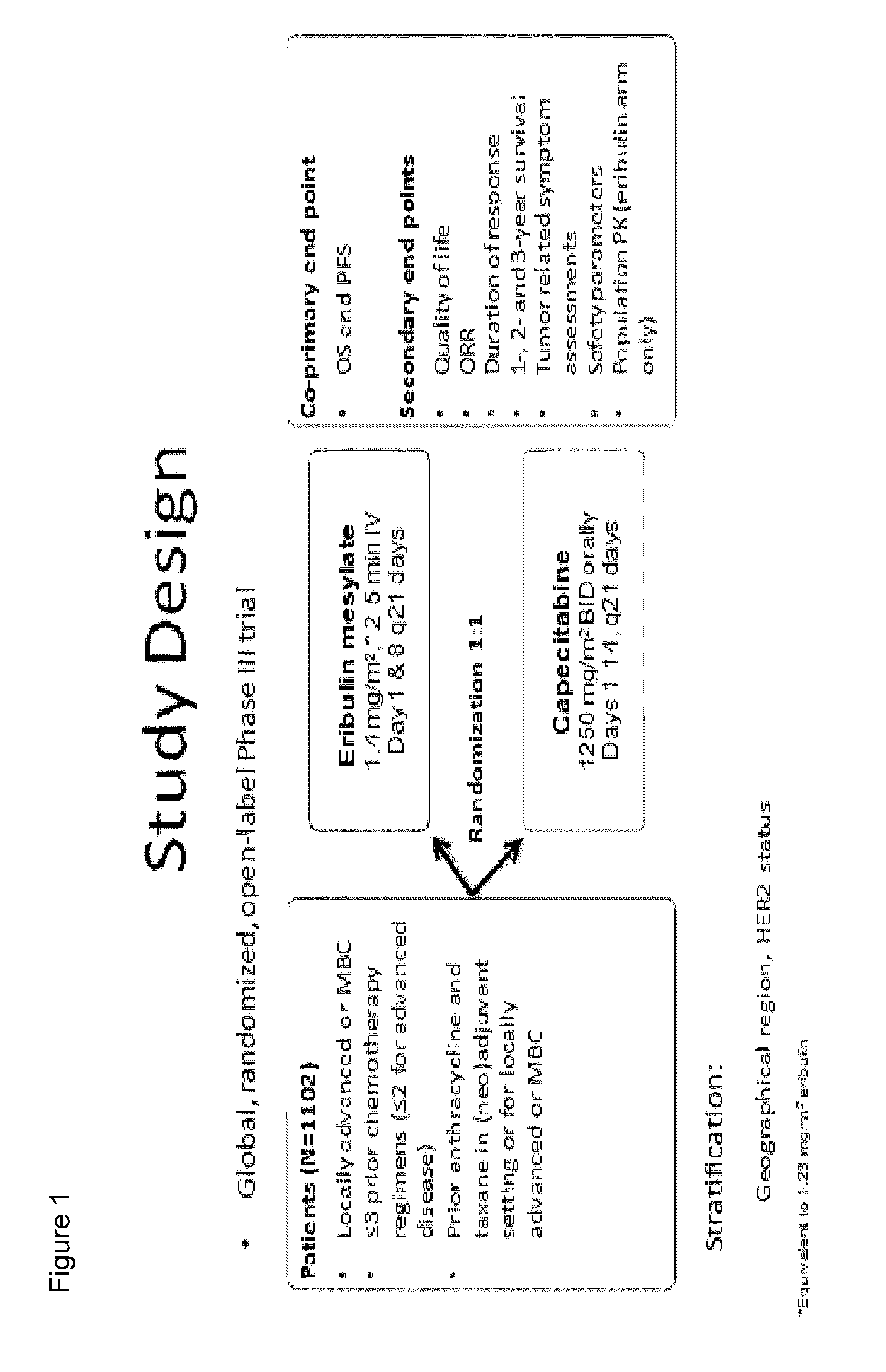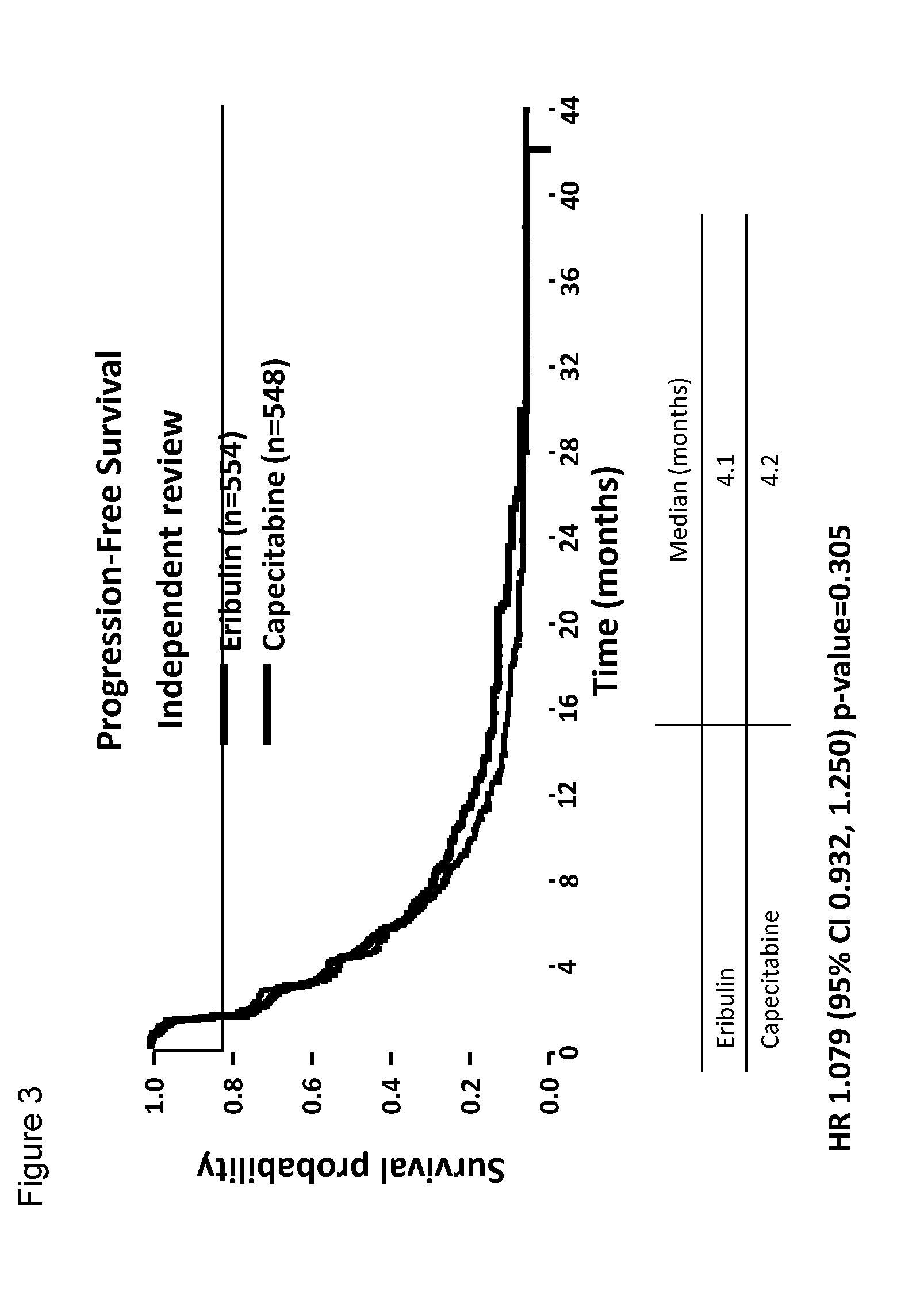Use of eribulin in the treatment of breast cancer
a technology of eribulin and breast cancer, which is applied in the direction of biocide, drug composition, instruments, etc., to achieve the effect of increasing the overall survival of 1 year
- Summary
- Abstract
- Description
- Claims
- Application Information
AI Technical Summary
Benefits of technology
Problems solved by technology
Method used
Image
Examples
example 1
Clinical Studies of Eribulin: Phase III Clinical Trial Comparing the Efficacy of Eribulin to the Efficacy of the Standard of Care Drug Capecitabine for Treatment of Breast Cancer
[0045]A global, randomized, open-label, two-parallel-arm, phase III clinical trial of eribulin (eribulin mesylate) and capecitabine was performed. Capecitabine is widely used in the treatment of metastatic breast cancer in 1st-, 2nd-, and 3rd-line settings. Eribulin mesylate is approved for treating patients who have previously received at least two chemotherapeutic regimens for the treatment of metastatic breast cancer, where the prior therapy should have included an anthracycline and a taxane. This study demonstrates that treatment of breast cancer with eribulin compares favorably with treatment with capecitabine in 1st, 2nd, and 3rd line regimens and with certain patient populations, treatment with eribulin provides superior results.
[0046]This study randomized 1102 patients who had up to three prior chemo...
example 2
Clinical Studies of Eribulin: Phase II Clinical Trial for use of Eribulin as a First-Line Treatment for HER2 Negative Breast Cancer (Part 1)
[0055]A multi-center, single-arm, phase II clinical trial of eribulin mesylate was performed to evaluate the objective response rate (ORR) (according to RECIST v1.1) to first-line treatment with single-agent eribulin mesylate in subjects with locally recurrent or metastatic HER2 negative breast cancer. Secondary objectives included the safety and tolerability of eribulin mesylate, time to first response, duration of response (DOR), and progression free survival (PFS). The study design, patient eligibility, and study parameters are shown in FIG. 8.
[0056]Patients were excluded from the study if they had inflammatory breast cancer or had received prior chemotherapy, biologic therapy, or investigational therapy for locally recurrent or metastatic breast cancer (patients who received prior endocrine therapy were permitted).
[0057]HER2 status was deter...
example 3
Clinical Studies of Eribulin: Phase II Clinical Trial for use of Eribulin as a First-Line Treatment for HER2 Negative Breast Cancer (Part 2)
[0062]This example provides additional data obtained from the study described above in Example 2. The baseline demographics and characteristics of patients in the study are as set forth below in Table 6.
TABLE 6Baseline Demographics and CharacteristicsEribulin-treated patientsCharacteristicN = 56Age, yearsMean (SD)57.0 (10.8) Range31-85Race, n (%)Caucasian42 (75.0)Black / African American12 (21.4)Asian1 (1.8)Other1 (1.8)ECOG performance status, n (%)032 (57.1)121 (37.5)23 (5.4)Breast cancer stage, n (%)Stage IV56 (100) Time from original diagnosis tometastatic breast cancer, n (%) 17 (30.4)≧3 months39 (69.6)ER / PR status, n (%)ER+ or PR+44 (78.6)ER− and PR−12 (21.4)Triple negative (ER− / PR− / HER2−), n (%)12 (21.4)Site of metastases, n (%)Visceral39 (69.6)Liver25 (44.6)Lung18 (32.1)Nonvisceral17 (30.4)Preexisting neuropathy, n (%) 9 (16.1)Prior antican...
PUM
| Property | Measurement | Unit |
|---|---|---|
| Time | aaaaa | aaaaa |
Abstract
Description
Claims
Application Information
 Login to View More
Login to View More - R&D
- Intellectual Property
- Life Sciences
- Materials
- Tech Scout
- Unparalleled Data Quality
- Higher Quality Content
- 60% Fewer Hallucinations
Browse by: Latest US Patents, China's latest patents, Technical Efficacy Thesaurus, Application Domain, Technology Topic, Popular Technical Reports.
© 2025 PatSnap. All rights reserved.Legal|Privacy policy|Modern Slavery Act Transparency Statement|Sitemap|About US| Contact US: help@patsnap.com



